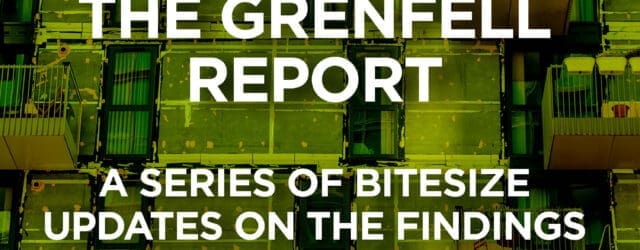GRENFELL PHASE 2 REPORT: IMPACT ON ARCHITECTS
October 2024This impact note focuses on the findings detailed in Phase 2 of the Grenfell Tower Inquiry, specifically concerning the appointed architect, Studio E Architects Limited. It also explores the recommendations that will impact architects and the wider construction industry going forward.
The Phase 2 Report was published on 4 September 2024, and in considerable length outlines the circumstances and causes of the fire. Our earlier article outlines the main findings.
The Report Findings
To summarise, the key findings in the Report involving the architect are as follows:
- The architect was responsible for the design of the external wall and choice of the materials used in construction.
- The architect lacked the necessary experience of working on high rise cladding projects[1], which signified a severe lack of fundamental understanding as to the architect’s role and responsibilities under a design and build contract. This was a serious consequence of the architect’s appointment without a competitive procurement process and no design competition.
- The investigation into the failings surrounding the Grenfell Tower highlight an industry-wide failure to properly investigate or understand the nature of the materials being selected, which is evidenced by findings of similar materials on hundreds of high-rise buildings. For example, NBS Specification discussions, which included the architect, concentrated on the cost and appearance of the ACM rainscreen cladding to the complete exclusion of its fire performance[2].
- Prior to the Grenfell Tower fire, architects regarded building control as an extension of the design team’s role , as opposed to having an independent regulatory role in major construction projects. This resulted in building control bodies co-operating with applicants to facilitate approval of proposals rather than enforcing the Building Regulations rigorously[3].
The Report finds that the architect failed to act with the appropriate standard of care and in accordance with statutory guidance, which required the architect to:
- Recognise that proposed products (including ACM rainscreen cladding) were unsuitable and dangerous and to warn against their use. This did not occur despite the architect being on notice that building control might not allow combustible insulation to be used in a rainscreen cladding system.
- Take active responsibility for the choice of the materials that were to form part of the external wall building and to be independently satisfied that materials selected by others were suitable for use in the relevant context. Instead, the architect assumed, without enquiry, that work produced by sub-contractors and consultants met the required standards[4].
- Ensure that the final safety strategy was completed or advise the client and principal designer of this requirement.
- Read the entire BBA certificate for any product that was recommended for a project, which would have highlighted that the rainscreen panels were available in a fire-retardant version, prompting the architect to ask for advice about the product and whether its use would be more appropriate[5].
- Understand the responsibility for its design work, and in its capacity as Lead Designer, responsibility for work carried out by sub-contractors[6]. Specifically, the architect failed to (i) check relevant designs as required; (ii) produce a proper cavity barrier strategy; (iii) produce detailed drawings of the window reveals, and (iv) notice that the materials specified for the window infill panels were unsuitable.
- Understand the relevant provisions of the Building Regulations, Approved Document B and industry guidance. The risks of using combustible materials in the external walls of high-rise buildings were well-known at the time and the architect should have been aware of them[7].
- Inform other parties that the architect had not satisfied themselves, by reference to testing or other data, that the materials included in the specification would result in an external wall compliant with building regulations[8].
Recommendations
Given the findings of the Grenfell Tower Inquiry, the Report makes the following recommendations specifically for architects:
- A review by the Architects Registration Board and the Royal Institute of British Architects to ensure that their improvements to the education and training of architects are sufficient in light of the Report’s findings[9].
- A statutory requirement that an application for building control approval in relation to the construction or refurbishment of a higher-risk building (Gateway 2) be supported by a statement from a senior manager of the principal designer under the Building Safety Act 2022. The statement should detail that all reasonable steps have been taken to ensure that on completion the building as designed will be safe, as is required by the Building Regulations[10].
Other recommendations in the Report that will impact architects include:
- That expertise should be questioned appropriately before and during the appointment of professionals on major construction projects.
- Clarification and revision of relevant Approved Documents and accompanying statutory guidance.
- The government appoint an independent panel to consider whether it is in the public interest for building control functions to be performed by those who have a commercial interest in the process, so that building control are reviewed as actioning a regulatory function.
- Establishment of a single construction regulator to oversee and inform all aspects of the industry.
- Use of a Chief Construction Adviser with good working knowledge and practical industry experience.
- Creation of a construction library with key information including product and test data.
Overall, the Report identifies that earlier reforms within the construction industry are insufficient and that further regulation and training are required across the industry to ensure that buildings and fire safety remain a priority.
You can find out more about building safety via our website. If you require support on any of the issues raised by the Report or its recommendations, please contact us.
[1] Phase 2 Report, Vol.4 Part 6: The refurbishment of Grenfell Tower, Chapter 52 ‘The appointment of Studio E’, paragraph 52.5
[2] Phase 2 Report, Vol. 4 Part 6: The refurbishment of Grenfell Tower, Chapter 55 ‘The choice of ACM PE rainscreen panels’, paragraph 55.33
[3] Phase 2 Report, Vol. 4 Part 6: The refurbishment of Grenfell Tower, Chapter 67 ‘Conclusions’, paragraph 67.17
[4] Phase 2 Report, Vol.4 Part 6: The refurbishment of Grenfell Tower, Chapter 63 ‘The contribution of Studio E’, paragraph 63.10
[5] Phase 2 Report, Vol.4 Part 6: The refurbishment of Grenfell Tower, Chapter 63 ‘The contribution of Studio E’, paragraph 63.34
[6] Phase 2 Report, Vol.4 Part 6: The refurbishment of Grenfell Tower, Chapter 63 ‘The contribution of Studio E’, paragraph 63.7
[7] Phase 2 Report, Vol. 1 Part 1: Introduction ‘Chapter 2: Executive summary’, paragraph 2.75
[8] Phase 2 Report, Vol.4 Part 6: The refurbishment of Grenfell Tower, Chapter 63 ‘The contribution of Studio E’, paragraph 63.23
[9] Phase 2 Report, Vol.7 Part 14, Chapter 113 ‘Recommendations’, paragraph 113.30
[10] Phase 2 Report, Vol.7 Part 14, Chapter 113 ‘Recommendations’, paragraph 113.31
Download PDF









